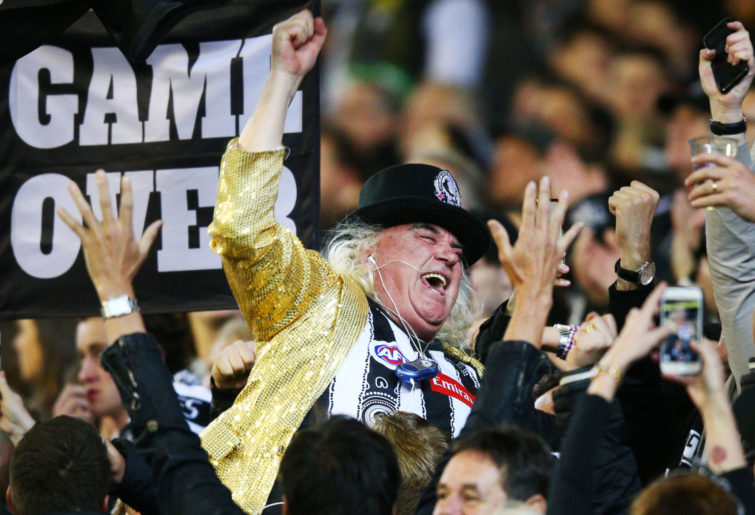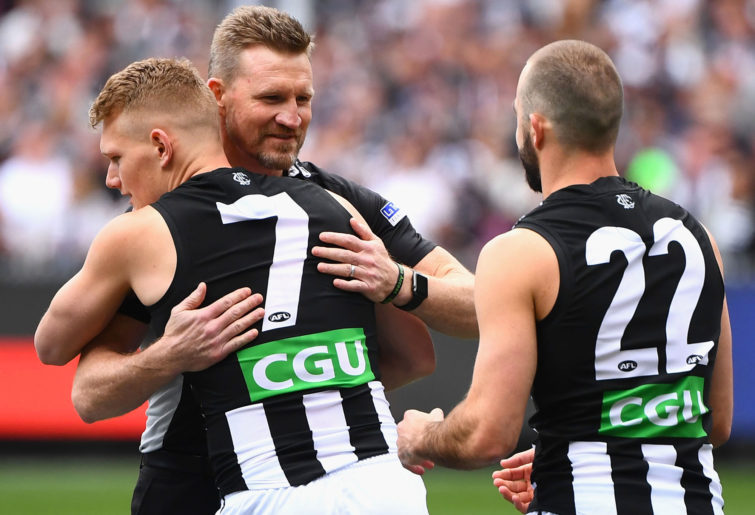As a supporter of Essendon since I was young, I was influenced by the hatred of Collingwood.
I never really knew why they were so hated. I simply followed the crowd and followed the silly sentiment, even though I lived in a Collingwood zone (Preston) where they were the most popular team.
At the 1977 VFL grand final, I was rather savage in my support for North Melbourne. I watched with a few mates that included future Magpies players at both grand finals.
Having made North my back-up team after watching Essendon get thrashed many times, I can’t really say I was loyal enough as an Essendon supporter given the number of times I attended North games during the 1970s.
Yet, as pathetic as I am, nothing is more pathetic than the simplistic hatred directed towards Collingwood.
After all, was there ever any real reason to hate them beyond their success?

(Photo by Paul Kane/Getty Images)
Whether you like it or not, Collingwood is one of Australia’s greatest sporting clubs, even though the Bombers have actually won the most VFL/AFL flags (16, tied with Carlton).
With maturity, I came to believe they were hated by most non-Collingwood supporters simply because of their success by either winning or playing in many grand finals.
By 1970, the Pies had won 13 flags and finished runner up 19 times, meaning they had made the grand final in 32 of 74 seasons.
The nearest team was Essendon with 23 appearances (won 12).
But, as of 2021, we still have simplistic commentary that supposedly justifies the widespread dislike.
For example, one recent online piece seeks to provide a historical basis for the dislike of Collingwood. It goes like this.
“With its Magpie name and toilet of a suburb, Collingwood fans were very much the type of people that respectable members of society would not want to associate with, let alone introduce to their parents.
“Essendon was a staunch lower-middle-class Protestant club, Melbourne was the Establishment Protestant club. Richmond and North Melbourne were Catholic clubs. Carlton, St Kilda and South Melbourne saw themselves as ‘respectable’ working class clubs and everyone saw Collingwood as occupying the lowest social status of all. Working class, Catholic and located in the poorest, most crowded, most unsanitary part of Melbourne, Collingwood players and supporters alike were regarded as aggressive, unruly, and profane.”
The same person then goes on to tell us that “their low social standing” and “the fans’ desire for success had been driven by a strong sense of social inferiority”, with this feeling supposedly responsible for Collingwood winning premierships in 1902, 1903, 1910, 1917, 1919, 1927, 1928, 1929, 1930, 1935 and 1936.
This person tells us the bleeding obvious. In a much tougher time when tribalism was a feature between different suburbs, including between Richmond and Collingwood, it was indeed Melbourne’s working-class suburbs that dominated the VFL prior to 1940, especially when you included Fitzroy’s eight premierships up to 1944.
But this is not the early 20th century.
It is 2021, and any hatred of the club cannot be justified by mumbo jumbo attacking the club if it is not without ample reason.
The simple truth is that Collingwood can claim to be one of Australia’s greatest football clubs of any code for real reasons that are due to organisation and passionate support.

(Photo by Michael Dodge/AFL Media/Getty Images)
With the Pies making 32 grand finals by 1970, it is hardly surprising they continued to draw big crowds in the 1970s.
While Richmond and Melbourne played their home games at the MCG with its large capacity, Collingwood played at the relatively small Victoria Park and drew the next highest average home crowd throughout the 1970s – an era when all six matches were mostly played on Saturday afternoon.
Even in 1976, the year they won the wooden spoon, Victoria Park averaged 23,500 and they featured in four of the six largest crowds played at the MCG or Waverley with their large capacities that season.
The large fan-base had been evident for many years, including when attracting the biggest ever VFL/AFL home-and-away crowd to this day on 16 June 1958 (the Queen’s Birthday fixture) when 99,346 fans attended the defeat of Melbourne, smashing the previous record by over 40,000.
The popularity of Collingwood even led to the successful 1980 film The Club, based on the play by the Australian playwright and dramatist David Williamson, said to be inspired by the backroom dealings and antics of the club.
But let us not limit the discussion of their prowess to the past.
Let us also consider the most recent decades given that the AFL has become a much more professional league, which is far less tribal due to many factors that make it much harder for any team to dominate, along with the reality that Victorian clubs now have to compete against interstate cities with just one or two teams.
Player and club loyalty to each other is now less evident given the national draft (from 1986), the salary cap (from 1987), and players seeking higher wages at a time when the average AFL wage has increased from about 1.33 times the average full-time wage in 1990 to 4.5 times the average Australian income earner, a development aided by the ongoing increase in television revenue, which reached $418 million per year for the 2017-2022 five-year period.

(Photo by Quinn Rooney/Getty Images)
At the playing level, the Magpies have been reasonably successful, making the finals 13 times during the last 20 seasons: 2002, 2003, 2006, 2007, 2008, 2009, 2010, 2011, 2012, 2013, 2018, 2019 and 2020.
While they won just one premiership (2010), they made four other grand finals (2002, 2003, 2011 and 2018), only matched by Hawthorn’s five appearances.
Sure, they’ve won just one premiership during the past 20 seasons. Hawthorn won four and it is three each for Brisbane, Geelong and Richmond, but it is also worth noting that Richmond did not make the finals in 13 of the past 20 seasons (2003-2012 and 2016).
From 2000 to 2019, Collingwood also achieved the highest home crowd average for most years, with only Richmond matching or surpassing their supporter attendance in around a quarter of those years, notably from 2017.
Since 2000, Collingwood has averaged over 50,000 per match per season with two years averaging over 60,000 (2009 and 2010).
But nothing may stop those who hate the club, who look for every reason to undermine its achievements and popularity.

(Photo by Ryan Pierse/Getty Images)
The same expert quoted above, who referred to the supposed riff raff associated with Collingwood to explain its incredible pre-1940 record, enlightens us with a summary of issues that are hardly unique to the Magpies, but all major sporting clubs.
Among the less silly comments, the club is riddled by off-field issues.
But in the end, on virtually all of these issues, the Pies are no worse than many other sporting clubs coming to terms with the need to influence and educate young players of various codes in a society where increasing social awareness and expectations about issues is indeed evident.
However, the reality is that Collingwood has always been a major VFL/AFL player and indeed deserves its status as one of Australia’s most famous and proud sporting clubs, whether the haters like it or not.
































































































